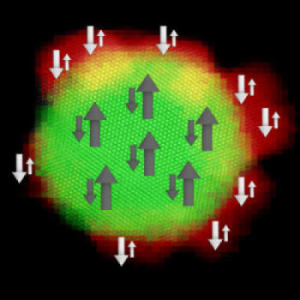
Researchers from the Universitat Autònoma de Barcelona (UAB) and the Institut Catala de Nanociencia i Nanotecnologia (ICN2) have created a new behaviour in magnetic core/shell nanoparticles. It could lead to the creation of even smaller and higher capacity digital memories.
 Electronic devices such as mobile phones and tablets spur on a scientific race to find smaller and smaller information processing and storage elements. One of the challenges in this race is to reproduce certain magnetic effects at nanometre scale.
Electronic devices such as mobile phones and tablets spur on a scientific race to find smaller and smaller information processing and storage elements. One of the challenges in this race is to reproduce certain magnetic effects at nanometre scale.
An international collaboration of scientists led by researchers from the Universitat Autònoma de Barcelona Department of Physics and the Institut Catala de Nanociencia i Nanotecnologia, and with the participation of the Universitat de Barcelona, has been able to reproduce in particles measuring 10 to 20 nanometres a magnetic phenomenon of great importance in magnetic devices: the antiferromagnetic coupling between layers.
This phenomenon appears when coupling layers of materials with different magnetic properties, which allows controlling the magnetic behaviour of the whole device. This property has very important technological applications. For example, it forms an important part of data reading systems found in hard drives and in the MRAM memories of computers and mobile devices.
Researchers have managed for the first time to reproduce this phenomenon in nanoscopic materials, measuring a mere few tens of atoms in diameter. They managed to do this by using iron-oxide particles surrounded by a thin layer of manganese-oxide and vice versa: manganese-oxide particles covered by a layer of iron-oxide. The discovery provides an unprecedented control of the magnetic behaviour of nanoparticles, since it permits controlling and easily adjusting their properties without having to manipulate their shape or composition, solely by controlling the temperature and the magnetic fields surrounding it.
“We've been able to reproduce a magnetic behaviour not previously observed in nanoparticles, and this paves the way for miniaturisation up to limits which seemed impossible for magnetic storage and other more sophisticated applications such as spin filters, magnetic codifiers and multi-level recording”, explain Josep Nogués, ICREA research professor, and Maria Dolors Baró, professor of Applied Physics.

 Previous page
Previous page Back to top
Back to top







